Digital Asset Management in the Cloud: If It’s Right for You
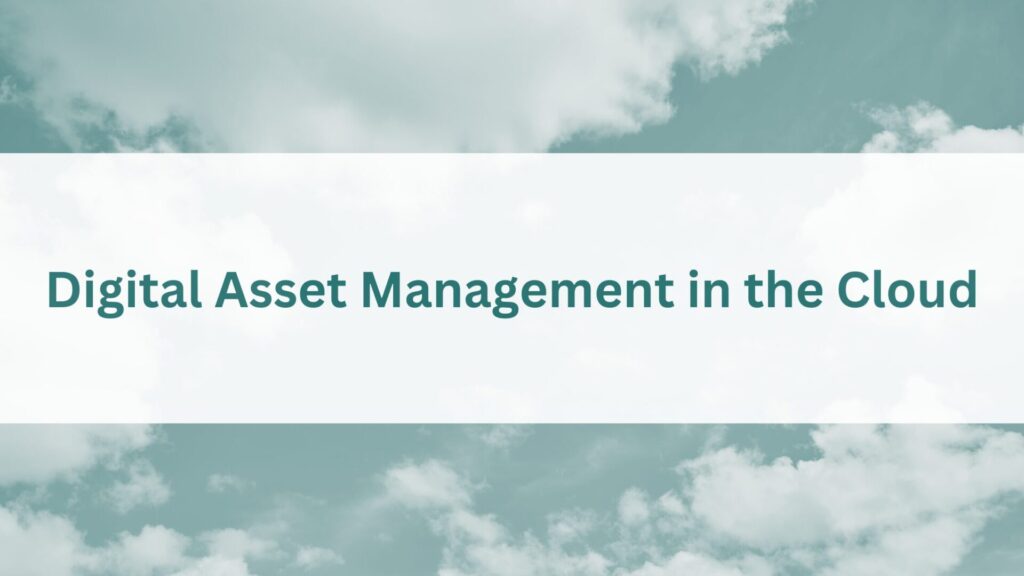
Choosing the right Digital Asset Management (DAM) system is crucial for streamlining operations, enhancing collaboration, and protecting content. Traditionally, on-premise hosting was the standard practice, with large corporations allocating whole teams and significant office space to oversee their IT infrastructure.
However, with the rise of “the cloud” and as the volume and value of digital assets continue to grow, the flexibility and scalability of a cloud-based DAM when compared to on-premise solutions become unmatched. But what makes a cloud DAM system stand out when compared to an on-premise DAM tool?
In this blog, we’ll explore the advantages of cloud-based digital asset management, delve into its essential functionalities, and examine how it stacks up against on-premise digital asset storage solutions. By the end of this blog, you’ll be equipped with the knowledge to make an informed decision on choosing the DAM solution that best aligns with your organization’s objectives, size, and workflow.
What Is Cloud Digital Asset Management (DAM)?
Cloud Digital Asset Management (DAM) is a cloud-based solution designed to store, organize, manage, access, and distribute digital assets from a centralized repository. Digital assets include various file types such as photos, videos, audio files, documents, and more.
The “cloud” aspect means that these assets are stored on servers accessible over the internet, offering advantages in terms of scalability, flexibility, and accessibility. Cloud DAM systems are accessible via a web browser and reside on a distributed network of remote servers, enabling global access from a multitude of devices.
Provided that the user maintains a stable internet connection, they can utilize the Cloud DAM software from any location.
| Read More: Looking to compare the pros and cons of a DAM system? Read about The Pros and Cons of DAM now. |
Cloud vs. On-Premise DAM
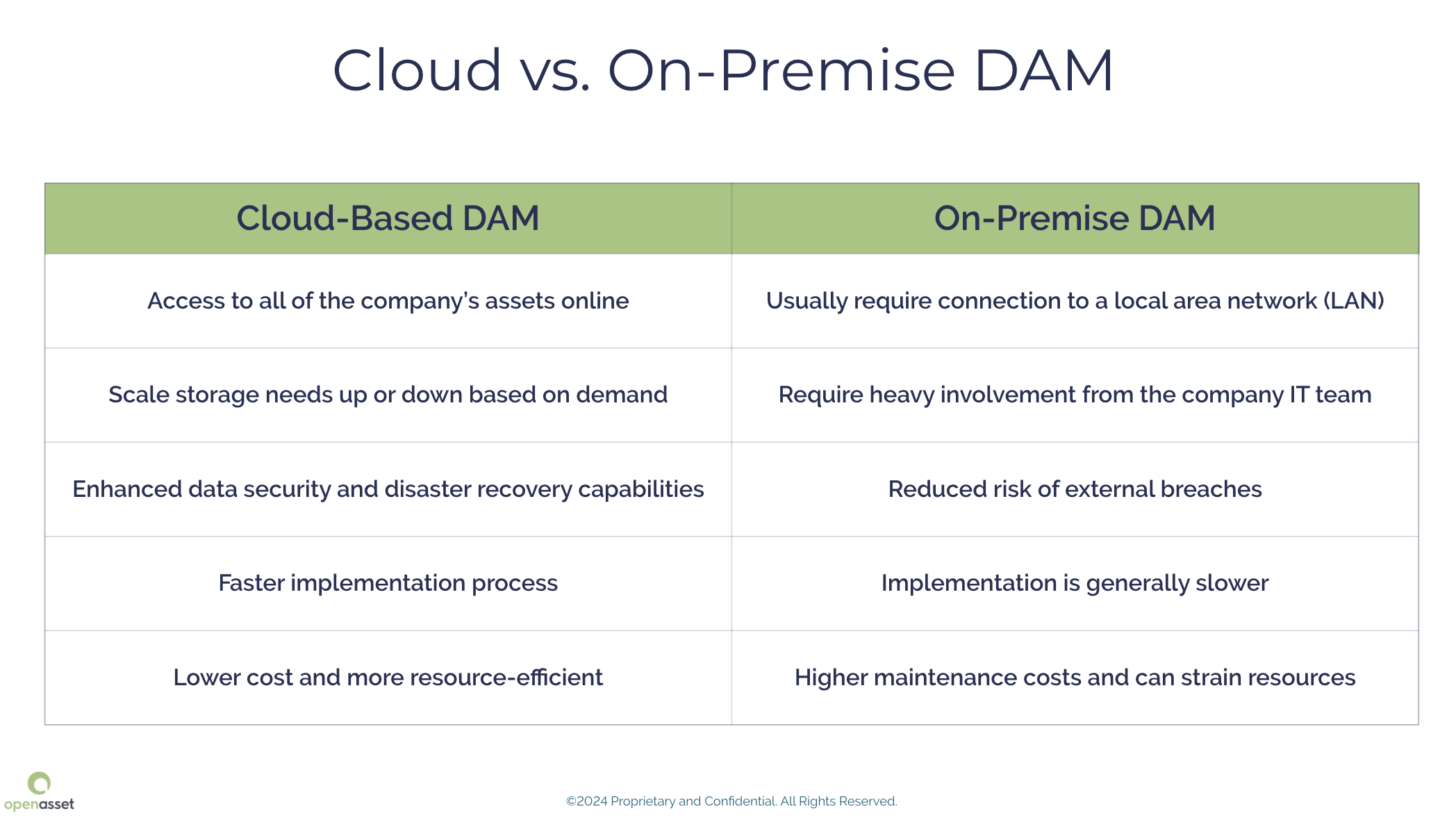
Both cloud-based DAM and on-premise DAM solutions offer organizations a centralized repository for the storage, organization, and management of digital assets. However, the primary distinction between these two types of platforms lies in their hosting environments.
Similar to various software options, DAM systems are set up locally (on-premise) or used over the web (cloud).
In the on-premise scenario, the responsibility for hosting and storing both the software and data falls on your company’s own servers.
However, in the web-based model, companies leverage the DAM provider’s IT infrastructure, where the provider operates the DAM on their servers, allowing companies to access the application through the internet.
Each choice offers distinct advantages to your business, which should be carefully evaluated and tested against your business model and existing organizational structure.
For example, while an on-premise DAM system may provide greater control, it might come with higher initial expenses and ongoing maintenance requirements. On the other hand, with digital asset management in the cloud, you can benefit from flexibility, scalability, and simplified remote collaboration. It all depends on your business needs and priorities.
Let’s take a look at each in more detail:
Cloud DAM
Cloud DAM software operates as an online solution for managing digital assets. Through these internet-based systems, users can manage a company’s digital files and have access to the entire collection of the company’s assets online.
With cloud DAM, organizations can easily scale their digital asset management cloud storage needs up or down based on demand, without the need for significant upfront investment in physical infrastructure. This model provides the flexibility to access and manage digital assets from any location, at any time, ensuring that team members can collaborate and share resources efficiently regardless of their geographical location.
Additionally, the cloud-based approach enhances data security and disaster recovery capabilities, as it allows for automatic backups and secure data transmission across the network.
Moreover, cloud DAM implementation is relatively quick, often only requiring a few weeks to a couple of months. The speed is due to the pre-existing infrastructure on the cloud provider’s side, which only needs configuration to match the organization’s requirements.
All of this means that cloud-based services for DAM prove to be more economical and efficient in terms of resources compared to maintaining an in-house digital asset management platform.
On-Premise DAM
An on-premise DAM system is hosted on a company’s own servers, usually requiring a connection to a local area network (LAN) for employees to store, organize, share, edit, and distribute digital assets.
These systems demand lots of involvement from the company’s IT department and can strain resources. However, platforms hosted internally offer unmatched security, total control, and clear visibility into the lifecycle of digital content.
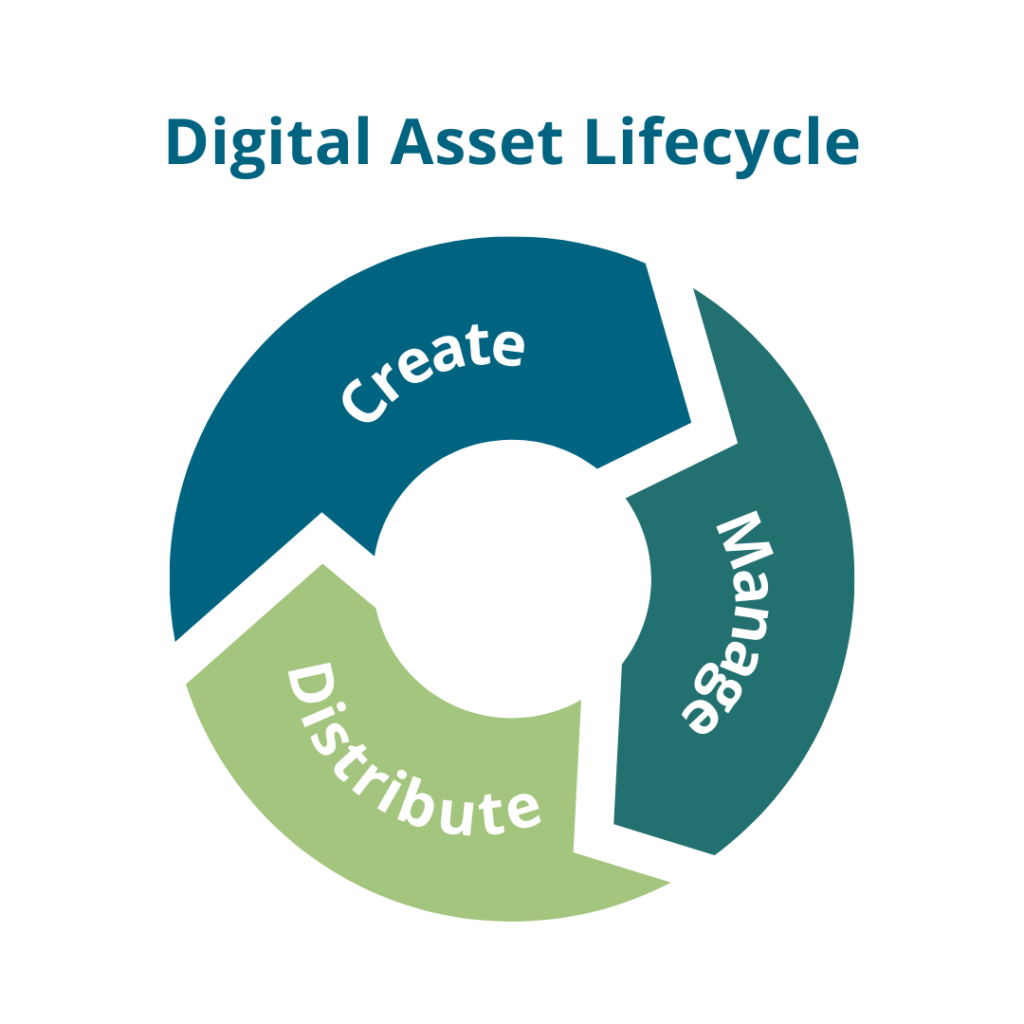
Moreover, the implementation of an on-premise DAM system is generally slower and can take several months to over a year. This timeline is longer due to the need for physical infrastructure setup, software installation, and comprehensive testing.
Benefits of Digital Asset Management in the Cloud
Today, almost every business leverages cloud-based technology. However, some organizations still haven’t harnessed one of the most powerful cloud-based systems available: Digital Asset Management (DAM). Here’s why you should consider cloud DAM to manage your digital assets:
1. No Need to Manage Licensing
As operations are entirely cloud-based and there’s no need for physical hardware installations, the hassle of managing or renewing various software licenses doesn’t exist. The pricing model follows a subscription structure, which can be paid in regular monthly payments.
This approach not only leads to fewer administrative tasks but also avoids the complexities and expenses linked to monitoring licenses, maintaining compliance, and handling renewals.
Moreover, cloud DAM ensures that businesses consistently use the most up-to-date version, freeing them from the conventional challenges associated with software licensing.
2. Faster Deployment and Upgrades
In contrast to the traditional on-premise setups, cloud DAM eliminates the need for physical installations or integration with the current IT landscape. This accelerates the setup process, allowing businesses to skip the time-consuming steps of hardware arrangement or compatibility verification.
The cloud framework streamlines the setup process, enabling immediate engagement in digital asset management, which is particularly advantageous for organizations looking to quickly deploy their DAM system.
Moreover, transitioning to newer versions of the software is more straightforward with cloud DAM, as upgrades are readily available online, getting rid of the necessity for manual installations on local drives.
This approach ensures that users consistently benefit from the latest functionalities, enhancements, and security updates without downtime or manual intervention, keeping the system up-to-date effortlessly.
3. Less Time and Work for IT
With cloud-based digital asset management solutions, the service provider is responsible for updates, issues, and ongoing maintenance. They take care of all the technical operations behind the scenes to ensure the platform operates seamlessly and efficiently.
Typically, a specialized operations team oversees the management of hardware and network connectivity, relieving the company’s IT staff from the burdens of day-to-day system upkeep. This makes cloud DAM an effective option for organizations with little IT resources or for IT departments that don’t have the bandwidth to take on more projects.
Additionally, this shift allows the IT department to focus on other critical organizational tasks, providing them with the opportunity to prioritize broader company objectives without being drawn back by routine maintenance tasks.
4. Scalability
A significant drawback of on-premise DAM is their difficulty to scale. Growing system resources such as storage space and user licenses requires manual intervention and time, often involving technical staff.
Starting with a configuration that includes large storage or numerous licenses isn’t realistic due to the substantial initial investment required. This scenario can be particularly challenging for startups operating on tight budgets.
However, on the other hand, cloud-based DAM provides a more flexible solution. With cloud digital asset management, scaling from 2,000 to 200,000 assets is possible and effortless, eliminating scalability concerns.
This feature is especially beneficial for organizations with heavy content requirements, enabling them to quickly increase their capacity without the delays associated with traditional expansions.
5. Robust Data Security
Cloud DAM systems have sometimes been met with concerns about their security, leading to a misconception that on-premise solutions are inherently more secure. However, cloud DAM systems implement advanced security protocols that often exceed those of on-premise solutions.
Cloud-based DAM providers typically invest heavily in security, offering advanced measures like encryption, multi-factor authentication, and regular security audits that might be beyond the reach of individual organizations. They often adhere to strict international security and privacy standards (e.g., GDPR, HIPAA), ensuring data is secure.
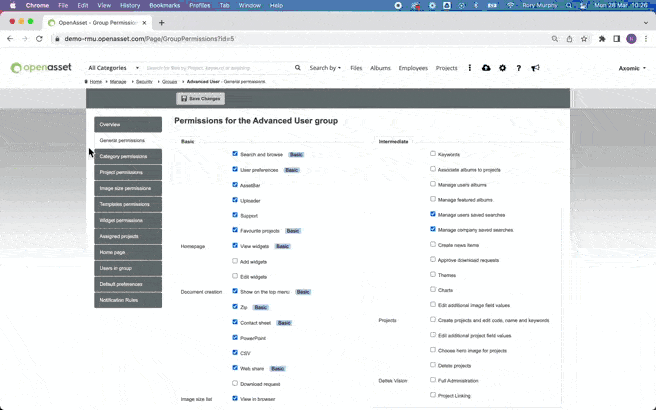
Moreover, cloud services usually include robust data backup and recovery processes. Cloud DAM provides effective data recovery strategies to protect against data loss due to hardware failure or natural disasters.
Additionally, cloud DAM allows for the customization of access and user roles, similar to on-premise systems, ensuring that digital assets are accessible only to relevant team members.
OpenAsset further bolsters security and organization by incorporating permission groups. This functionality enables precise control over which digital assets can be searched for and accessed, adding an extra layer of security to your digital content management.
6. Improved Collaboration
DAM is essential for collaborative workflows, offering a centralized and structured platform that allows all team members to access and handle digital assets efficiently. Cloud-based digital asset management enables teams, whether remote teams or teams spread across various locations, to effortlessly access files from anywhere globally and collaborate instantly.
Regardless of your location or device, provided you have an internet connection, you can access, share, and collaboratively edit your digital assets in real-time. This unified system simplifies workflow processes and enhances communication and teamwork among team members.
7. Cost-Effective Solution
Cloud DAM software enables brands to avoid the upfront costs associated with purchasing hardware and software, allowing them to pay only for the storage and functionalities they utilize. This system adapts and expands alongside the business’s growth trajectory.
For example, if the quantity of digital assets significantly increases over time, the system effortlessly accommodates this growth without hitting capacity constraints. Additional storage can be acquired as needed, providing financial flexibility without requiring a large initial investment. This adaptability ensures that storage can be scaled up smoothly as requirements grow.
Additionally, with everything hosted online, users gain access to the platform without the need to install specific software on each device or rely on specialized hardware.
This makes a cloud digital asset management system a cost-effective and scalable solution, charging only for the resources used, all the while delivering advanced DAM features.
8. Improved Asset Organization
As your volume of digital assets grows, the necessity for asset organization intensifies.
The integration of advanced search capabilities, artificial intelligence (AI), and comprehensive digital asset management features helps marketers efficiently and securely store, find, use, and share digital assets.
Moreover, the implementation of AI-driven auto-tagging, sophisticated filtering, and diverse intuitive search options ensures that each team member can easily access the required assets, guaranteeing the appropriate use of every asset.
Within a comprehensive cloud DAM system like OpenAsset, image tagging is significantly streamlined through automatic labeling software that identifies and tags images by their content upon importation. This automation eliminates the need for manual tagging of image files, liberating your marketing team to focus on other high-value tasks.
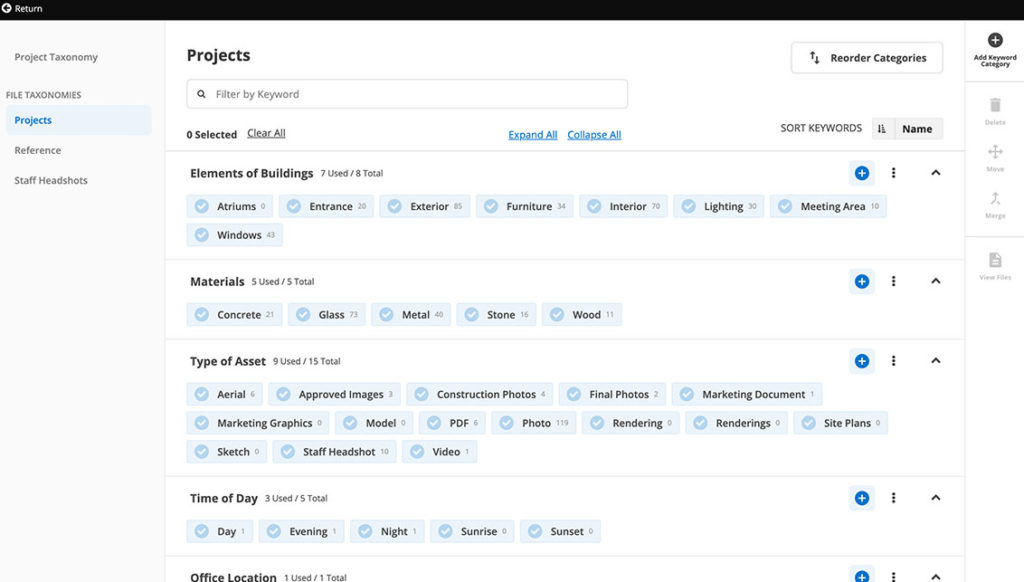
Additionally, customization of image tagging keywords is available to align more closely with your team’s specific needs.
OpenAsset enables the incorporation of detailed descriptors beyond basic attributes like color or location, including client names, internal project identifiers, and other custom details. Tags related to specific projects can be applied automatically to all associated files, ensuring cohesive asset organization.
Furthermore, image tagging facilitates the categorization of images, simplifying the search process. Users have the flexibility to adjust image tags, tailoring the search function to display specific image categories based on keywords.
This feature enhances search efficiency, particularly for locating images relevant to ongoing campaigns or projects, making the search experience quicker and more user-friendly.
9. Simplified Sharing
Cloud DAM streamlines the secure distribution of digital assets to the appropriate parties precisely when needed. For example, OpenAsset’s Portal feature is a game-changing innovation designed specifically for AEC firms looking to enhance their digital asset management and sharing processes. This new tool allows a highly customizable and centralized approach to sharing digital assets directly from the OpenAsset system.
Moreover, Cloud DAM allows you to manage access rights for both internal and external users, therefore enhancing your brand’s integrity.
With a cloud-based digital asset management system, concerns about file duplication or incorrect file naming conventions disappear. Cloud DAM enables the efficient sharing of assets via links, permitting another team or individual team member to access the asset from any device. It’s not necessary to upload the image another time and create duplicates.
Should an asset require updates, it can be done in the same location, eliminating the need for exchanging multiple attachments and ensuring a seamless and organized asset transfer process.
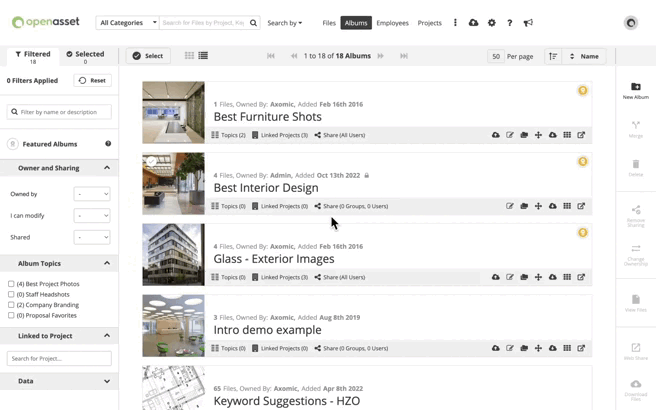
Additionally, every asset shared is safeguarded within the DAM environment, offering more than just secure sharing. The system provides visibility into asset interactions, enabling you to track who accessed an asset when it was accessed, and any modifications made, thus maintaining a secure and transparent asset management ecosystem.
10. Enhance Efficiency
Navigating through an organizational archive filled with thousands of images can be overwhelming and counterproductive. Cloud-based DAM simplifies this process through effective asset management techniques.
Implementing cloud digital asset management solutions can boost a company’s operational efficiencies while maintaining brand uniformity and fostering enhanced collaboration across various sectors, including architecture, construction, and engineering.
Assets can be organized, classified, and arranged into distinct categories and file folders, streamlining the management process. Furthermore, team members are empowered to share, update versions, and regulate access to assets, which boosts workflow productivity and sustains brand coherence.
Organizing assets in folders by team, project, or purpose minimizes disorder and facilitates seamless cooperation among diverse teams. This organization leads to increased asset visibility, enabling teams to achieve higher productivity with less effort.
11. Seamless Integration With Existing Workflows
Cloud DAM systems offer the ability to effortlessly integrate with a diverse range of platforms and tools, from CRMs and content creation tools to marketing platforms. This fosters a cohesive workflow, minimizing data isolation and ensuring digital assets are readily available and utilizable across different departments and systems.
Lack of effective integration between your DAM solution and other third-party software can lead to data bottlenecks, resulting in more disruption than the anticipated productivity boost.
The adaptability of a DAM system in the cloud through various integrations means it can be customized to meet the specific requirements of any organization.
For example, OpenAsset, specifically designed for AEC professionals, provides smooth integration with the essential tools and software common in these industries, including direct links to CRM and ERP systems that are fundamental to AEC operations.
Moreover, OpenAsset increases document creation by linking with vital tools such as InDesign, allowing for direct access to your asset library.
This integration streamlines the design process, enabling users to drag and drop images directly from the DAM software into InDesign or PowerPoint presentations, eliminating broken image links and automating the preservation of image links for documents that incorporate cloud-stored images.
If you can’t find the integration you’re looking for, OpenAsset’s REST Application Programming Interface (API) also supports bespoke custom integration and functionality, enabling organizations to develop tailored solutions or integrations that perfectly align with their specific operational needs and processes.
These DAM integrations merge smoothly into existing workflows, reducing interruptions and maximizing the effectiveness of current technology investments, thus significantly elevating productivity levels.
12. Advanced Search Capabilities
Advanced search capabilities significantly reduce the time users spend searching, enabling them to concentrate on tasks that add value to the business.
A robust cloud DAM system ensures that all your digital content is effortlessly searchable and accessible across your team and organization. Navigating through your digital assets should be straightforward.
The cloud DAM should tailor its search capabilities to meet the evolving demands of your specific industry. For example, a DAM tool designed for AEC firms will make the application of keywords and metadata to projects a seamless task.
Advanced search capabilities through digital asset management in the cloud can offer a broader range of options through features like image similarity and flexible taxonomy and configuration. This facilitates the rapid and efficient identification of the ideal digital assets for any project, presentation, or proposal.

| BONUS CLOUD DAM BENEFIT: Learn how a cloud-based DAM solution can help you Select the Best Employees for Your RFP Responses and Create Employee Resumes in Seconds. Read about The Employee Module now. |
Who Benefits From Cloud-Based Digital Asset Management?
If you’re still not sure if a cloud-based digital asset management solution is right for you, here are some diverse roles and industries cloud DAM caters to and can make a significant impact in:
Roles That Use Cloud-Based DAM Systems
Let’s start by taking a look at some roles that find cloud DAM not only useful but necessary in their day-to-day responsibilities:
Marketers
Marketing teams typically lead the charge in utilizing assets. They leverage cloud digital asset management to streamline their workflows, ensuring that campaigns will launch efficiently and on schedule.
With immediate access to a centralized library of branded assets, marketing teams can maintain consistency across all channels, improve collaboration, and analyze asset performance to optimize future campaigns.
Proposal Writers
For proposal writers, cloud DAM designed for AEC firms is invaluable for accessing the latest company assets, ensuring that every project proposal is accurate, up-to-date, and aligned with the brand’s identity. This type of DAM will also have advanced features tailored to the AEC industry and offer industry-specific integration to improve workflows.
These capabilities and top features speed up the proposal creation process and enhance the quality of submissions, resulting in firms winning more business.
Designers
Designers rely on cloud-based media asset management for its ability to offer instant access to a variety of assets, enabling creative freedom while adhering to brand guidelines. It simplifies the search for specific assets and collaboration with other team members, making it easier to create compelling visual content.
Contractors and Freelancers
Contractors and freelancers find cloud DAM systems especially beneficial for their flexibility and ease of access to necessary assets without being tied to a specific location. This capability allows them to work more efficiently with various clients, ensuring they use the correct, approved assets for each project.
Industries That Use Cloud Digital Asset Management
Now, let’s take a look at some industries that rely on cloud DAM:
Architecture
Cloud DAM for Architecture supports the organization and sharing of complex project files, designs, and images among team members and clients. In fact, teams that use software have an average 45% proposal win rate. Cloud-based digital asset management enables architecture firms to fully leverage their investment in photography by facilitating the reuse and repurposing of their images.
It streamlines the collaborative process, ensuring that all stakeholders have access to the most current project assets, facilitating a more integrated approach to design and project management.
Moreover, with the capabilities of a cloud DAM solution, architecture firms can create higher-quality proposals faster than ever.
| TIP: Looking for more ways to ensure you’re creating winning architecture proposals every time? Get your Architecture Proposal Template now. |
Engineering
Engineers leverage cloud DAM to manage a large amount of technical documents, CAD files, and project plans. It enables seamless collaboration across different engineering disciplines and locations, improving the efficiency of project workflows and helping to maintain a single source of truth for all project-related digital assets.
Construction
Cloud DAM for the construction industry is beneficial because it allows construction firms to have centralized access to project blueprints, schedules, contracts, and site photos. This accessibility enhances coordination among contractors, clients, and project managers, ensuring that everyone is working from the most updated documents and reducing the risk of costly mistakes.
Moreover, with industry-specific integrations, such as CPM integrations that enable image sharing between Construction Management and Marketing teams, workflows become more streamlined.
Agencies
With a cloud-based DAM, agencies can quickly share assets with clients for approval, collaborate on projects, and ensure that all outputs are aligned with brand guidelines, thereby enhancing client satisfaction and project turnaround times.
| TIP: Not working in any of the industries mentioned above? For a DAM system in other industries, read our blog on The Best Non-AEC DAM Providers now. |
How to Start With a Cloud DAM System

Leveraging a cloud DAM system offers significant advantages for brands, yet achieving these benefits depends on proper setup and implementation. This may include:
- Education
- Migration
- Configuration
- Adoption
- Launching
- Training
- Ongoing technical support
The purpose of each stage is to ensure your team is fully prepared and equipped. Here’s what you can expect from implementing a top cloud-based DAM: OpenAsset.
Step 1: Education Stage
Initially, our priority will be to establish realistic objectives and schedules for your firm’s integration process, along with providing an introduction to the system’s fundamentals. We’ll arrange meetings to deliver in-depth training on OpenAsset, covering its functionalities, advantages, and typical processes.
During these sessions, we’ll also explore your existing workflows and how you currently manage project and digital asset storage. By the conclusion of this phase, we will have jointly crafted a migration strategy to efficiently move all your content into OpenAsset.
Step 2: Migration Stage
The migration phase tends to be the most labor-intensive part of the process. In this stage, your team will mainly focus on readying content for upload to OpenAsset, working primarily outside the system.
Many of our new clients opt for our Data Migration Service to facilitate the transfer of files (including images, videos, PDFs, and documents) from their current storage solutions (be it another DAM system, local or network servers, or shared drives) to OpenAsset.
The purpose of this service is to streamline the upload process to OpenAsset, demanding minimal effort on the client’s part as the OpenAsset Support team oversees the migration.
After we’ve successfully transferred all your essential content to the platform, we’ll guide you through leveraging your content to its fullest potential. This discussion will be pivotal in laying the groundwork for your team’s enduring success.
Step 3: Configuration Stage
In the configuration phase, we collaborate with you to tailor and adapt your OpenAsset system to meet your unique needs. We guide you through the process and allocate tasks to guarantee that the system can meet your specific criteria and is user-friendly for beginners.
This phase begins after your content has been successfully uploaded to the system, at which point we offer training on its usage. Our main focus during this period is to ensure you are comfortable and proficient in using the system. To achieve this, we offer detailed instructions on standard workflows to empower your team for success.
Step 4: Transition to Adoption
After completing the configuration phase, we move to the onboarding process’s final step. At this point, your Implementation Manager will assume a support function and introduce your firm to our Customer Success team. In partnership with the Customer Success Team, we’ll address any outstanding tasks or resolve any issues before proceeding to the ‘Adoption’ phase.
In the ‘Adoption’ phase, the focus shifts to deploying the system across your organization, encouraging users to incorporate OpenAsset into their regular activities. By this point, your system will be ready for broader use. Although your team might still be adding keywords to files or uploading new projects, the system will already be a valuable resource for other team members to begin utilizing effectively.
We will work together to design and execute a training plan, establish a deployment strategy, and fine-tune your workflows to ensure they meet your objectives. This joint effort aims to finalize all necessary preparations ahead of the system’s official rollout.
Step 5: Prepare for Launch
To ensure a smooth introduction to your OpenAsset system, we will arrange a series of training and preparatory sessions for your team. These sessions cover four essential topics:
- A follow-up discussion after training
- Managing workflows using OpenAsset
- A meeting to regroup with key stakeholders
- A review session with executives to assess business implications
Following the initial OpenAsset launch session(s), we commit to conducting monthly check-ins to ensure your team remains aligned and on course.
Start With a Robust Cloud-Based DAM: OpenAsset
The transition to cloud DAM from on-premise DAM is not just a trend but a strategic move towards more agile and responsive asset management. However, if you’re not sure which DAM is right for you, and you’re an AEC professional, OpenAsset is the #1 choice.
Embracing a robust cloud-based Digital Asset Management (DAM) system like OpenAsset can revolutionize the way AEC industries and professionals manage, share, and utilize their digital assets.
As a DAM solution designed for the built world, OpenAsset offers tailored solutions that streamline workflows, enhance collaboration, and maintain brand consistency across all AEC projects.
OpenAsset’s Digital Asset Management platform makes AEC proposals simpler, faster, and more successful. That’s why 99% of customers renew. Start your journey with OpenAsset and unlock the full potential of your digital assets. Ready to stand out and pave the way for success in an increasingly competitive industry?
The post Digital Asset Management in the Cloud: If It’s Right for You appeared first on OpenAsset.